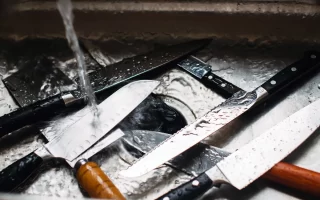How do I clean my pocket knife? There’s nothing like a clean, sharp, and smooth opening EDC pocket knife that’s ready to slice, cut, pierce at a moment’s notice. No matter how useful your favorite knife is, if it’s dull and dingy it can cause some serious damage while making cuts. So, wondering how to keep your knife in tip-top shape, clean, and ready for action?
Generally, pocket knife maintenance starts with keeping your folder sharp, clean, and lubricated. In this blog post, I will cover some of my favorite and most universal effective methods of cleaning pocket knives. You can clean any folding knife following these methods.
So read on to find out how to clean a pocket knife.
Things that you require
- Thick rubber gloves
- An old toothbrush
- Mild dish soap/detergent
- Some cotton swab
- Baking soda
- White vinegar
- Household lubricant (3-in-1 oil)
- A rag or any soft cloth or paper towels (whatever you have)
Step 1: Wear the rubber gloves
First thing first, before cleaning a knife you should always put on a pair of thick rubber gloves to keep your hand protected from any accidental cuts and harmful chemicals getting into your skin.
Step 2: Remove piled up dust with a toothpick
Open the knife blade all the way up. You may find sands, grime, lint or loose dust pilled up on the pivot screw. With the help of a toothpick, remove the stuck-up gunks from your knife handle and the moving part. If your knife’s pivot point or the locking mechanism is not working smoothly, this shall fix the problem. Also, make sure you are doing this step on a dry knife because wet gunk is harder to clean.
Step 3: Rinse out & Scrub Down
Now that you have removes the lint and grimes from the knife, run it under the warm part. One way to do this step is using a hand shower. Spray water and flush away to clean inside of the handle and get rid of any extra dirt that may be stuck in between the scales. Or if you are a little bit extra like me, you can use a compressed air can and blow out the loose dust.
Now there are three things you can do in this step.
If you have a rust spot or rust stain on the knife blade then follow the next step;
Step 3(1) Scrub with Baking soda paste
Take 2 tablespoons of baking soda into a bowl. Pour an appropriate amount of water so that you can make a thick paste. Mix them together and make a nice paste. Now take your toothbrush and transfer the paste to it. If you have light rust on the blade then scrub the blade by scoping a little bit of baking soda paste and continue doing it till you are satisfied with the result. If it is an old pocket knife and the blade has a deep rust stain, then I’d suggest you cover the entire knife with baking soda paste ( only if it has stainless steel handle, don’t spread the paste on a wooden handle ). Let it rest for an hour. And then with the toothbrush give it a good scrub. That will get rid of the rust from your knife.
If your knife has stubborn substances then,
Step 3 (2) Brush it with three in one oil
Take your brush/ Q-tip/ Rag and moisture it with 3-in-1 oil and give it a hard scrub. Stubborn deposits such as tree saps are the hardest substance to clean. When nothing else works, I reach out to hand sanitizer or 3-in-1 oil. It takes pines and any other saps right off
If your blade has no issues with rust then,
Step 3(3) Scrub with dish soap
Take one of those green scrubbers (the one we use in the kitchen) or nylon pad and spread some dish detergent or any mild soap on your knife. While doing this make sure you have opened the blade all the way and there is no dust, lint in the locking mechanism. Soap can make your knife slippery so pay close attention for a secured grip. Scrub thoroughly and clean all the grimes and sand on the moving parts.
If you are cleaning a multi-tool knife, say a swiss army knife, if you have to clean each tool individually. Open each blade one at a time, after scrubbing close it. You have to clean one by one and do it individually just to be safe. A soapy knife can be extremely dangerous to handle. Once you are done cleaning all the parts individually open it all. Now it’s time to clean the inside of the handle cavity. With the cotton swabs or Q tips, you can get to the corners of the inside and remove all the cruds and dirt that are piled up.
When you are satisfied with the cleaning, rinse thoroughly and carefully with warm water.
Step 4: Pat it dry
Dry the entire knife. You can use a paper towel or any clean cloth to soak up the extra water. Then let it air dry fully. One mistake a lot of people do, they take apart the whole knife to clean it. But I would say it is just a way to ruin a good knife. As most of the knives, these days come with a warranty. If you mail the company to fix your dull knife, or to clean it, their excellent warranty covers it. So, taking apart a knife can void the warranty. Don’t do that.
Step 5: Lube it
Now that your knife id fully dried, it’s time to give it an oil massage. There are several kinds of lubricants that you can use. I prefer petroleum-based lubricant for my pocket knives. Take few drops of it and lubricate the pivot screw, blade, and other moving parts. If your knife is used for cutting foodstuffs then consider using mineral oil, olive oil, or coconut oil (basically any food-safe oil). I use olive oil and coconut oil a lot on my kitchen knives. I also use gun oil in my hunting knife. Works just fine!
Step 6: Wipe the blade down
Use a paper towel or a rag to wipe off the excess oil. Do use some drops of lubricant as a little goes a long way. When you wipe down the blade, it will prevent it from getting rust in the future.
If your knife has a wooden handle, wiping it down with a little bit of lube will give it a nice shine.
Clean knife with White Vinegar
Things that you need:
- White vinegar
- A bowl
- Clean rag
Step 1: Take the vinegar
Pour down white vinegar in a bowl or a pan. A wide plate is also preferable. Just take something where you can accommodate the knife with the blade all the way out.
Step 2: Soak the knife into white vinegar
Soak the entire knife in vinegar for 5-6 minutes. If your knife has a wooden handle then only soak the blade portion where the rust is. If the scales inside the handle have rust and you don’t want to soak the entire knife, take a paper towel or cotton swabs, soak it in vinegar, and put it on the rust stain.
Step 3: Wipe it off
Wipe the knife after soaking it in vinegar for 5 minutes. By now, your knife is supposed to sparkle. If not follow the above-mentioned steps 3, 4, 5, and 6 and that will get the job done.
Other than these two methods, there are some rust removal products on the market that I swear by. WD-40, ZEP, and CLR. You have to pour them into a bowl and soak them for some minutes (Read the instruction manual) and scrub it, clean them off. And your knife will be all ready to use in no time. These only works for severe rust. If your knife blade is chipped and already worn down by the rust, don’t expect any rust remover to fix it.
How to keep your knife rust-free?
Even though most pocket knives are made of stainless steel they can and will rust if exposed to water, high humidity, or sweat for extended periods and remember it’s possible that parts of your knives like spring, bolts, lock, and screws may not be made of stainless steel. So for preventing your knife from getting rust, follow these steps;
1. Dry fully before storing
After cleaning your knife make sure you dry it perfectly. There should not be a single drop of water remaining. If necessary, sundry it. Place your knife open in the sun for 10-20 minutes. That will make certain there’s no moisture left on the blade.
2. Clean it as soon as you see a very thin rust
Just when you see that the blade is about to get rust you need to take measurements. For a very thin layer of rust, mix a little bit of lemon juice with your dish soap and that will clean off the rust layer.
3. Lube it often
Wipe it down with few drops of oil regularly. Apply penetrating oil to the moving parts and all the joints to prevent these parts to get rust. These parts are prone to get rust easily. Also oiling the moving parts will make your knife silky smooth. However, make sure you don’t have excess oil on the surface. As it will attract cruds and sands.
Conclusion
A pocket knife has so many uses but it all goes in vain if the knife itself is not sharp and clean. To me, rust is a knife’s cancer. You need to look out for it and clean it off at the first sign of rust. If you take good care of your knife and maintain it properly it will last for a long time.
Hope this post was helpful. While cleaning the knives be patient. The rust will eventually come off.

Hi, my name is Taras Kulakov and I’m a knife enthusiast. I have been collecting knives for over 30 years and I’ve owned literally thousands of different models over that time. My goal with this site is to share some of what I’ve learned about knives. You can find more info about Taras Kulakov here.




